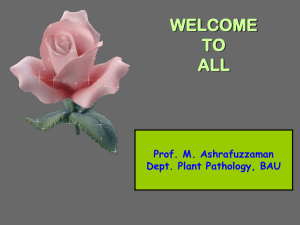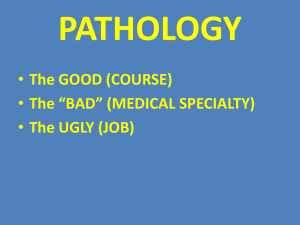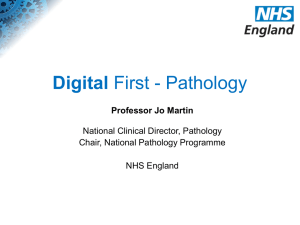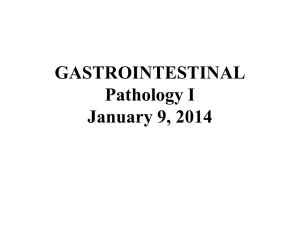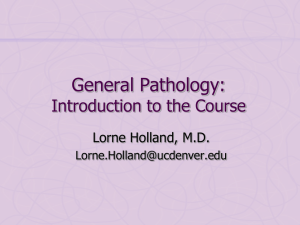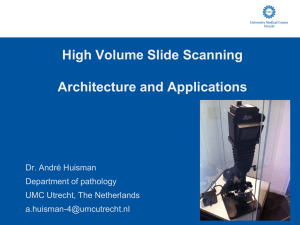Course Contents-VPP
advertisement
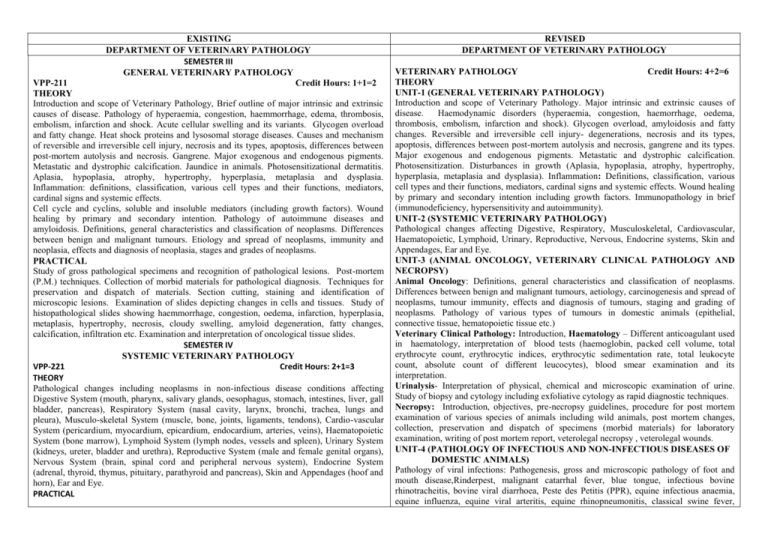
EXISTING DEPARTMENT OF VETERINARY PATHOLOGY SEMESTER III GENERAL VETERINARY PATHOLOGY Credit Hours: 1+1=2 VPP-211 THEORY Introduction and scope of Veterinary Pathology, Brief outline of major intrinsic and extrinsic causes of disease. Pathology of hyperaemia, congestion, haemmorrhage, edema, thrombosis, embolism, infarction and shock. Acute cellular swelling and its variants. Glycogen overload and fatty change. Heat shock proteins and lysosomal storage diseases. Causes and mechanism of reversible and irreversible cell injury, necrosis and its types, apoptosis, differences between post-mortem autolysis and necrosis. Gangrene. Major exogenous and endogenous pigments. Metastatic and dystrophic calcification. Jaundice in animals. Photosensitizational dermatitis. Aplasia, hypoplasia, atrophy, hypertrophy, hyperplasia, metaplasia and dysplasia. Inflammation: definitions, classification, various cell types and their functions, mediators, cardinal signs and systemic effects. Cell cycle and cyclins, soluble and insoluble mediators (including growth factors). Wound healing by primary and secondary intention. Pathology of autoimmune diseases and amyloidosis. Definitions, general characteristics and classification of neoplasms. Differences between benign and malignant tumours. Etiology and spread of neoplasms, immunity and neoplasia, effects and diagnosis of neoplasia, stages and grades of neoplasms. PRACTICAL Study of gross pathological specimens and recognition of pathological lesions. Post-mortem (P.M.) techniques. Collection of morbid materials for pathological diagnosis. Techniques for preservation and dispatch of materials. Section cutting, staining and identification of microscopic lesions. Examination of slides depicting changes in cells and tissues. Study of histopathological slides showing haemmorrhage, congestion, oedema, infarction, hyperplasia, metaplasis, hypertrophy, necrosis, cloudy swelling, amyloid degeneration, fatty changes, calcification, infiltration etc. Examination and interpretation of oncological tissue slides. SEMESTER IV SYSTEMIC VETERINARY PATHOLOGY VPP-221 Credit Hours: 2+1=3 THEORY Pathological changes including neoplasms in non-infectious disease conditions affecting Digestive System (mouth, pharynx, salivary glands, oesophagus, stomach, intestines, liver, gall bladder, pancreas), Respiratory System (nasal cavity, larynx, bronchi, trachea, lungs and pleura), Musculo-skeletal System (muscle, bone, joints, ligaments, tendons), Cardio-vascular System (pericardium, myocardium, epicardium, endocardium, arteries, veins), Haematopoietic System (bone marrow), Lymphoid System (lymph nodes, vessels and spleen), Urinary System (kidneys, ureter, bladder and urethra), Reproductive System (male and female genital organs), Nervous System (brain, spinal cord and peripheral nervous system), Endocrine System (adrenal, thyroid, thymus, pituitary, parathyroid and pancreas), Skin and Appendages (hoof and horn), Ear and Eye. PRACTICAL REVISED DEPARTMENT OF VETERINARY PATHOLOGY VETERINARY PATHOLOGY Credit Hours: 4+2=6 THEORY UNIT-1 (GENERAL VETERINARY PATHOLOGY) Introduction and scope of Veterinary Pathology. Major intrinsic and extrinsic causes of disease. Haemodynamic disorders (hyperaemia, congestion, haemorrhage, oedema, thrombosis, embolism, infarction and shock). Glycogen overload, amyloidosis and fatty changes. Reversible and irreversible cell injury- degenerations, necrosis and its types, apoptosis, differences between post-mortem autolysis and necrosis, gangrene and its types. Major exogenous and endogenous pigments. Metastatic and dystrophic calcification. Photosensitization. Disturbances in growth (Aplasia, hypoplasia, atrophy, hypertrophy, hyperplasia, metaplasia and dysplasia). Inflammation: Definitions, classification, various cell types and their functions, mediators, cardinal signs and systemic effects. Wound healing by primary and secondary intention including growth factors. Immunopathology in brief (immunodeficiency, hypersensitivity and autoimmunity). UNIT-2 (SYSTEMIC VETERINARY PATHOLOGY) Pathological changes affecting Digestive, Respiratory, Musculoskeletal, Cardiovascular, Haematopoietic, Lymphoid, Urinary, Reproductive, Nervous, Endocrine systems, Skin and Appendages, Ear and Eye. UNIT-3 (ANIMAL ONCOLOGY, VETERINARY CLINICAL PATHOLOGY AND NECROPSY) Animal Oncology: Definitions, general characteristics and classification of neoplasms. Differences between benign and malignant tumours, aetiology, carcinogenesis and spread of neoplasms, tumour immunity, effects and diagnosis of tumours, staging and grading of neoplasms. Pathology of various types of tumours in domestic animals (epithelial, connective tissue, hematopoietic tissue etc.) Veterinary Clinical Pathology: Introduction, Haematology – Different anticoagulant used in haematology, interpretation of blood tests (haemoglobin, packed cell volume, total erythrocyte count, erythrocytic indices, erythrocytic sedimentation rate, total leukocyte count, absolute count of different leucocytes), blood smear examination and its interpretation. Urinalysis- Interpretation of physical, chemical and microscopic examination of urine. Study of biopsy and cytology including exfoliative cytology as rapid diagnostic techniques. Necropsy: Introduction, objectives, pre-necropsy guidelines, procedure for post mortem examination of various species of animals including wild animals, post mortem changes, collection, preservation and dispatch of specimens (morbid materials) for laboratory examination, writing of post mortem report, veterolegal necropsy , veterolegal wounds. UNIT-4 (PATHOLOGY OF INFECTIOUS AND NON-INFECTIOUS DISEASES OF DOMESTIC ANIMALS) Pathology of viral infections: Pathogenesis, gross and microscopic pathology of foot and mouth disease,Rinderpest, malignant catarrhal fever, blue tongue, infectious bovine rhinotracheitis, bovine viral diarrhoea, Peste des Petitis (PPR), equine infectious anaemia, equine influenza, equine viral arteritis, equine rhinopneumonitis, classical swine fever, Post-mortem examination of large and small animals, recording of gross lesions and compiling the post-mortem report (including vetero-legal cases), dispatch of morbid material in veterolegal cases, study of gross specimens and histopathological slides pertaining to systemic pathology. Collection and examination of clinico-pathological specimens (blood, urine, body fluids, etc.) for diagnosis of systemic affections. SEMESTER V SPECIAL VETERINARY PATHOLOGY VPP-311 Credit Hours: 2+1=3 THEORY General pathology of viral infections. Pathogenesis, gross and microscopic pathology of Foot and mouth disease, Rinderpest, malignant catarrhal fever, blue tongue, infectious bovine rhinotracheitis, bovine viral diarrhoea, caprine encephalitis-arthritis complex, PPR, equine infectious anaemia, equine influenza, equine viral arteritis, equine rhinopneumonitis, African horse sickness, classical swine fever, Aujeszkey’s disease, swine influenza, rabies, canine distemper, infectious canine hepatitis, canine parvovirus, feline panleukopenia, maedi, jaagziekte, scrapie, bovine and feline spongioform encephalopathies, pox virus diseases in different animals. Vesicular stomatitis, vesicular exanthema, equine encephalomyelitis, diseases caused by rota and corona viruses, General pathology of bacterial infections. Pathogenesis, gross and microscopic pathology of Tuberculosis, Johne’s disease, actinomycosis, actinobacillosis, anthrax, Clostridial group of diseases, streptococosis including strangles in horses, staphylococosis, glanders, pasteurellosis, leptospirosis, listeriosis, swine erysipelas, brucellosis, corynebacterium infections, nocardiosis, campylobacteriosis, Haemophilus, salmonellosis and colibacillosis in swine. General pathology of mycoplasmal, chlamydial and rickettsial infections and their differentiation. Pathogenesis, gross and microscopic pathology of contagious bovine pleuropneumonia (CBPP), contagious caprine pleuropneumonia (CCPP), porcine enzootic pneumonia, chlamydial group of diseases and anaplasmosis, Q-fever and ehrilichosis. General pathology of mycotic infections. Pathogenesis, gross and microscopic pathology of superficial and deep mycoses – ringworm, favus, aspergillosis, zygomycosis, histoplasmosis, cryptococosis and candidiasis. General pathology of helminthic and protozoal infections. Pathogenesis, gross and microscopic pathology of fascioliasis, amphistomiasis, ascariasis, strongylosis, hemonchosis, spirocercosis, filariasis, hookworm, tapeworm infections, coccidiosis, toxoplasmosis, babesiosis, theileriasis and trypanosomiasis. Pathological changes in nutritional and metabolic diseases: (deficiency/excess of carbohydrates, proteins, fats, minerals and vitamins and in conditions like milk fever, pregnancy toxaemia, post-parturient haemoglobinuria, ketosis, hypomagnesemic tetany, azoturia, piglet anaemia and sway back/enzootic ataxia and Rheumatism like syndrome). General pathology of toxicosis. Pathogenesis, gross and microscopic pathology of heavy metal toxicities like arsenic, copper, lead, mercury, cadmium, strychnine, nitrate/nitrite, HCN, fluoride, oxalate toxicities, insecticide/pesticide poisoning. Pathogenesis, gross and microscopic pathology of aflatoxicosis, ochratoxicosis, trichothecosis and ergotoxicosis. Pathology of exotic and emerging diseases. PRACTICAL Post-mortem examination of large and small animals for diagnosis of special diseases. Study of gross lesions particularly those of pathognomonic significance. Study of histopathological slides pertaining to special pathology including special staining of causative agents. Study of rapid diagnostic techniques like biopsy, exfoliative cytology, frozen sectioning. swine influenza, rabies, canine distemper, infectious canine hepatitis, canine parvovirus infection, feline panleukopenia, maedi, jaagziekte, pox virus diseases in different animals. Vesicular stomatitis, vesicular exanthema, equine encephalomyelitis, diseases caused by rota and corona viruses. Pathology of prion diseases (scrapie, bovine and feline spongiform encephalopathies). Pathology of bacterial infections: Pathogenesis, gross and microscopic pathology of tuberculosis, Johne's disease, actinomycosis, actinobacillosis, anthrax, clostridial group of diseases (black quarter, black disease, enterotoxaemia, braxy, botulism tetanus), streptococosis including strangles in horses, staphylococosis, glanders, pasteurellosis, leptospirosis, listeriosis, swine erysipelas, brucellosis, corynebacterium infections (caseous lymphadenitis, pseudotuberculosis), campylobacteriosis, salmonellosis, and colibacillosis including oedema disease in pigs, and necrobacillosis). Pathogenesis, gross and microscopic pathology of mycoplasma infection (contagious bovine pleuropneumonia, contagious caprine pleuropneumonia, porcine enzootic pneumonia), diseases of chlamydial group, Q-fever, anaplasmosis and ehrlichiosis. Pathogenesis, gross and microscopic pathology of superficial and deep mycoses - ringworm (dermatophytosis), aspergillosis, zygomycosis, histoplasmosis, cryptococosis, rhinosporidiosis and candidiasis. Pathogenesis, gross and microscopic pathology of aflatoxicosis, ochratoxicosis, trichothecosis, Degnala disease and ergotoxicosis. Pathogenesis, gross and microscopic pathology of fasciolosis, babesiosis, theileriosis and trypanosomosis. Pathological changes (in brief) of amphistomiasis, ascariasis, strongylosis, haemonchosis, spirocercosis, filariasis, hookworm, tapeworm infections, coccidiosis, toxoplasmosis, cryptosporidiosis, Pathological changes of nutritional imbalances (in brief) due to carbohydrates, proteins, fats, minerals and vitamins and metabolic diseases (milk fever, pregnancy toxaemia, postparturient haemoglobinuria, ketosis, hypomagnesemic tetany, azoturia, and sway back/enzootic ataxia, downer cow syndrome, pica and Rheumatism like syndrome). Gross and microscopic pathologyin (brief) of toxicities like arsenic, copper, lead, mercury, cadmium, strychnine, nitrate/nitrite, hydrocyanic acid, fluoride, selenium and oxalates; insecticide/pesticide poisoning, plant poisoning (braken fern, gossypol, ratti and lantana) UNIT-5 (AVIAN PATHOLOGY) Avian Inflammation, Viral Diseases: Pathogenesis, gross and microscopic pathology of Ranikhet disease, infectious bursal disease, infectious bronchitis, infectious laryngotracheitis, fowl pox, avian influenza, Marek's disease, leukosis/sarcoma group of diseases, reticuloendotheliosis, avian encephalomyelitis, inclusion body hepatitis, hydropericardium syndrome, chicken infectious anaemia, avian nephritis, egg drop syndrome, reovirus infections. Bacterial Diseases: Pathogenesis, gross and microscopic pathology of colibacillosis, infectious coryza, clostridial diseases, salmonella infections, fowl cholera, tuberculosis and spirochaetosis. Pathogenesis, gross and microscopic pathology of Mycoplasma infections, chlamydiosis. Pathogenesis, gross and microscopic pathology of aspergillosis, thrush, favus, aflatoxicosis, ochratoxicosis and trichothecosis. Gross and microscopic pathology (in brief) of helminthic diseases (flukes, cestodes, nematodes), protozoal diseases (coccidiosis, histomoniasis), ectoparasites. SEMESTER VI AVIAN PATHOLOGY VPP-321 Credit Hours: 1+1=2 THEORY Viral Diseases: Pathogenesis, gross and microscopic pathology of Ranikhet disease, infectious bursal disease, infectious bronchitis, infectious laryngotracheitis, fowl pox, avian influenza, Marek’s disease, leukosis/sarcoma group of diseases, avian encephalomyelitis, inclusion body hepatitis, hydropericardium syndrome, chicken infectious anaemia. Avian nephritis, egg drop syndrome, infectious stunting syndrome, reovirus infections. Bacterial Diseases: Pathogenesis, gross and microscopic pathology of Colibacillosis (colisepticaemia, yolk sac infection, egg peritonitis, coligranuloma), infectious coryza, clostridial diseases (botulism, necrotic enteritis, gangrenous dermatitis, ulcerative enteritis), salmonellosis (Pullorum disease, fowl typhoid, paratyphoid infection), fowl cholera, tuberculosis and spirochaetosis Mycoplasmal and Chlamydial Diseases: Pathogenesis, gross and microscopic pathology of Mycoplasma gallisepticum infection (chronic respiratory disease), Mycoplasma synoviae infection, Avian chlamydiosis (psittacosis). Fungal Diseases: Pathogenesis, gross and microscopic pathology of aspergillosis, thrush and favus. Mycotoxicosis: Pathogenesis, gross and microscopic pathology of Aflatoxicosis, ochratoxicosis and trichothecenes. Parasitic Diseases: Pathogenesis, gross and microscopic pathology of Helminthic diseases (flukes, cestodes, nematodes), protozoal diseases (coccidiosis, histomoniasis), ectoparasites, avian malaria Nutritional and metabolic diseases: Pathogenesis, gross and microscopic pathology of major diseases due to deficiency/excess of carbohydrates, proteins, minerals and vitamins in poultry. Vices and Miscellaneous Diseases: Pathology of important vices and miscellaneous conditions. Pathology of exotic and emerging poultry diseases. PRACTICAL Post mortem examination and diagnosis of poultry diseases based upon clinical signs and gross lesions. Writing of postmortem report. Collection, preservation and dispatch of morbid materials in poultry diseases. Clinical examination of blood, faeces and other tissues/fluids for poultry disease diagnosis. Submission of feed samples for analysis. Study of gross specimens and histopathological slides of different diseases of poultry. SEMESTER VI AQUATIC ANIMAL DISEASES, HEALTH CARE AND MANAGEMENT VPP-322 Credit Hours: 1+1=2 THEORY Introduction to aquatic animals, aquatic animal ecology and national economy. Fishery as a method of recycling animal and poultry wastes and feed surplus. Types of common aquatics animals, fresh and saline water fish, their collection. Care and breeding, egg and spawn management. Integrated aquaculture. Ornamental fisheries. Aquatic animal feeds and feeding. Economic production; Pond and nursery management. Inland and marine capture fisheries, Stock assessment and population dynamics. Fish harvesting and process technology, fish Gross and microscopic pathology of nutritional imbalances due to carbohydrates, proteins, minerals and vitamins. Miscellaneous diseases (Heat stroke, vent gleet, internal layer, false layer, pendulous crop, breast blister, ascites syndrome, fatty liver and kidney syndrome, fatty liver syndrome, cage layer fatigue, gout, hemorrhagic syndrome, round heart disease, impaction of oviduct, egg bound condition, bumble foot) and common vices. UNIT-6 (PATHOLOGY OF DISEASES OF LABORATORY ANIMALS, FISH AND WILD ANIMALS) Pathology of important diseases of rats, mice, and guinea pigs (Tyzzer’s disease, Pseudotuberculosis, Salmonellosis, Infectious ectromelia, Infantile diarrhea, Murine hepatitis virus, Lymphocytic choriomeningitis); Pathology of important diseases of rabbits (Pasteurellosis, Blue breasts, Treponematosis, Enterotoxaemia, Rabbit pox , Infectious myxomatosis, Papillomatosis , Coccidiosis, Mite infestation) ; Pathology of important diseases of fish (Environmental hypoxia ,Temprature stress, Poisoning of ammonia, nitrate and nitrite , Improper salinity, Gas bubble disease, Hypercarbia, Metal Poisoning, Nutritional deficiency diseases, Furucnculosis, Vibriosis, Enteric red mouth disease , Bacterial kidney diseases, Tuberculosis, Columnaris infection, Bacterial gill disease, Bacterial haemorrhagic septicaemia, Viral haemorrhagic speticaemia, Infectious pancreatic necrosis, Infectious haematopoietic necrosis, Koi herpes virus disease, Typical water mould infection, Epizootic ulcerative syndrome, Branchiomycosis ,Swinging disease, Important parasitic infection); Gross and microscopic pathology of important diseases of wild animals (West Nile Fever, Rabies, FMD, Pox, Kyasanaur forest disease, Infectious hepatitis virus, Anthrax, Tuberculosis, Colibacillosis, Clostridial infections Trypanosomosis, Babesiosis, Theileriosis, Nutritional deficiency diseases) PRACTICAL UNIT-1 (GENERAL VETERINARY PATHOLOGY) Study of gross pathological specimens and recognition of pathological lesions. Histopathological techniques– Processing of tissue for paraffin embedding technique, section cutting, staining and identification of microscopic lesions. Examination of histopathological slides showing general pathological alterations. UNIT-2 (SYSTEMIC VETERINARY PATHOLOGY) Study of gross specimens and histopathological slides pertaining to systemic pathology. UNIT-3 (ANIMAL ONCOLOGY, VETERINARY CLINICAL PATHOLOGY AND NECROPSY Macroscopic and microscopic examinations of various types of benign and malignant tumours. Examination of blood for routine haematological tests in domestic animals and poultry. Physical, chemical and microscopic examination of urine. Post mortem examination of different species of animals including wild and laboratory animals. UNIT-4 (PATHOLOGY OF INFECTIOUS AND NON-INFECTIOUS DISEASES OF DOMESTIC ANIMALS) Post mortem examination and its interpretations, Study of gross specimens and histopathological slides of various organs pertaining to infectious and non- infectious diseases of domestic animals. Demonstration of causative agents in tissue section by special staining methods and use of rapid diagnostic tests. preservation, inspection, utilization of fish in animal feed. Anatomy, physiology, immunology and inflammatory response in finfish and shellfish (crustaceans and mollusks). OIE regulations related to aquatic animal health. Viral, bacterial, mycotic and parasitic diseases affecting aquatic animals. Nutritional and toxic pathology. Miscellaneous non-infectious diseases associated with physicochemical abnormalities of water. Neoplasia of teleosts. Vaccines and vaccination. PRACTICAL Identification of culturable fishes. Techniques to study growth and age in fishes. Composite fish culture techniques. Management of artificial diets, induced breeding techniques. Determination of hydrological parameters, qualitative and quantitative analysis of phyto-and zoo-planktons. Fishing gears and crafts. Management of a typical fish farm. Normal anatomy and histology of finfish and shellfish. Ante-mortem and post-mortem examination of fish. Haematology. Histopathology of important viral, bacterial, fungal and parasitic diseases. Visit to organized fishery. (To be taught jointly with Departments of Livestock Production Management and Veterinary Medicine) UNIT-5 (AVIAN PATHOLOGY) Post mortem examination of poultry diseases and writing of post mortem report. Collection, preservation and dispatch of morbid materials in poultry diseases. Study of gross specimens and histopathological slides of different diseases of poultry. UNIT-6 (PATHOLOGY OF DISEASES OF LABORATORY ANIMALS, FISH AND WILD ANIMALS) Ante mortem and post mortem examination of fish. Haematology on fish blood. Study of gross and microscopic changes of diseases affecting laboratory animals, fish and wild animals. ANNUAL EXAMINATION PAPERS THEORY Paper-I Paper-II PRACTICAL Paper-I Paper-II UNITS MAXIMUM MARKS WEIGHTAGE 1,2 and 3 4, 5 and 6 50 50 25 25 1,2 and 3 4, 5 and 6 30 30 15 15
